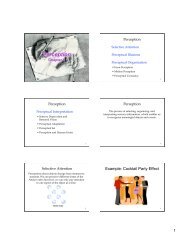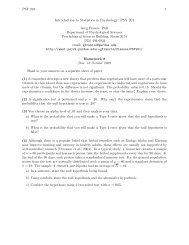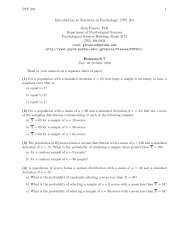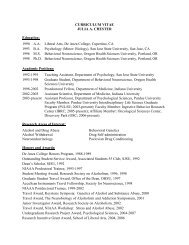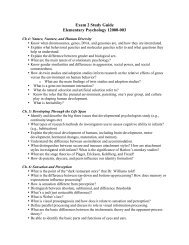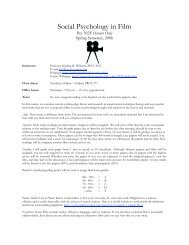Introduction to Cognitive Psychology - Department of Psychological ...
Introduction to Cognitive Psychology - Department of Psychological ...
Introduction to Cognitive Psychology - Department of Psychological ...
Create successful ePaper yourself
Turn your PDF publications into a flip-book with our unique Google optimized e-Paper software.
Pr<strong>of</strong>essor Greg Francis 1/6/11Pro<strong>to</strong>types!! Results are based on data from 169 participants.!! Pattern type Reaction time (ms)!! Pro<strong>to</strong>types ! !686!!! Variants ! !719!!! Unanswered by this (and many other) experiments is what a pro<strong>to</strong>type is:!! a “thing” that resides in memory and contains information about the categoryfeatures!! the result <strong>of</strong> processing information!! A bit <strong>of</strong> thought suggests it is the result <strong>of</strong> processing informationPro<strong>to</strong>types!! Consider the types <strong>of</strong> concepts you can have!! and how specific they can be!! things: bird, dog, chair, shoe,…!! actions: walking, running, sleeping,…!! goal-derived: “things <strong>to</strong> eat on a diet”, “things <strong>to</strong> carry out <strong>of</strong> a housein case <strong>of</strong> a fire”,...!! ad hoc: “things that could fall on your head”, “things you might seewhile in Paris”, “gifts <strong>to</strong> give one’s former high school friend who hasjust had her second baby”,...!! When studied, these concepts all seem <strong>to</strong> have pro<strong>to</strong>typecharacteristicsPurdue UniversityPurdue UniversityPro<strong>to</strong>types!! We can generate new concepts from oldconcepts!!it’s inconceivable that every possible pro<strong>to</strong>type existsready <strong>to</strong> be used!!some must just be built as they are needed!!perhaps even the pro<strong>to</strong>types for simple concepts like“bird” or “shoe” are also just built when they areneeded!! A theory that can account for this processingapproach is exemplar theoryPurdue UniversityExemplars!! A concept consists <strong>of</strong> lots <strong>of</strong> examples <strong>of</strong> theconcept!!e.g., a “c<strong>of</strong>fee cup” concept might contain lots <strong>of</strong>examples <strong>of</strong> c<strong>of</strong>fee cupsPurdue UniversityExemplars!! Comparing an object <strong>to</strong> see if it is a c<strong>of</strong>fee cupinvolves comparing it <strong>to</strong> each example in memoryand seeing if it matches anything well enoughExemplars!! Even if it is a new object, it may match severalexemplars well enough <strong>to</strong> generate an overallresponse <strong>to</strong> indicate it is a c<strong>of</strong>fee cupPurdue UniversityPurdue UniversityPSY 200: Intro. <strong>to</strong> <strong>Cognitive</strong> <strong>Psychology</strong> 4



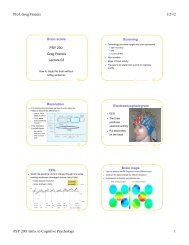

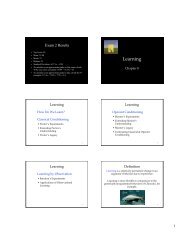
![Exam 4 Study Guide[1]](https://img.yumpu.com/45196739/1/190x245/exam-4-study-guide1.jpg?quality=85)
